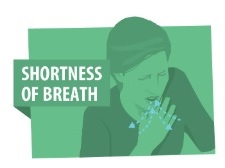Difficulty breathing
Difficulty breathing, also known as dyspnea, is a common symptom that can occur in people of all ages and for a variety of reasons. It can be a sign of a serious medical condition, such as asthma, pneumonia, or heart disease, or it can be caused by less serious issues such as anxiety or physical exertion. In this article, we will explore the causes, symptoms, and treatment options for difficulty breathing.
Causes of Difficulty Breathing
- There are many potential causes of difficulty breathing, ranging from temporary and mild to chronic and serious. Some of the most common causes include:
- Asthma: A chronic lung condition characterized by inflammation and narrowing of the airways, which can cause difficulty breathing, coughing, and wheezing.
- Chronic obstructive pulmonary disease COPD: A group of lung diseases that cause inflammation and obstruction of the airways, making it difficult to breathe. COPD is often caused by long-term exposure to smoke, pollution, or other irritants.
- Pneumonia: A lung infection that can cause inflammation and fluid buildup in the lungs, leading to difficulty breathing.
- Heart disease: Heart conditions such as heart failure or a heart attack can lead to fluid buildup in the lungs or decreased blood flow, both of which can cause difficulty breathing.
- Anxiety or panic attacks: Anxiety or panic attacks can cause shortness of breath or a feeling of being unable to breathe.
- Physical exertion: Activities that require significant physical exertion, such as exercise or manual labor, can cause shortness of breath.
Symptoms of Difficulty Breathing
- The symptoms of difficulty breathing can vary depending on the underlying cause, but may include:
- Shortness of breath or feeling of being unable to catch one's breath
- Rapid or shallow breathing
- Tightness or pressure in the chest
- Wheezing or coughing
- Feeling lightheaded or dizzy
- Bluish lips or fingernails
- Sweating or clammy skin
Treatment Options for Difficulty Breathing
- The treatment options for difficulty breathing depend on the underlying cause of the symptom. Some common treatment options include:
- Medications: Medications such as bronchodilators, corticosteroids, and antibiotics may be prescribed to treat the underlying condition causing difficulty breathing.
- Oxygen therapy: Oxygen therapy may be necessary if the individual is not getting enough oxygen.
- Lifestyle changes: Lifestyle changes such as quitting smoking, losing weight, or avoiding triggers such as allergens or pollutants can help improve difficulty breathing.
- Breathing exercises: Breathing exercises such as pursed-lip breathing or diaphragmatic breathing can help to slow down breathing and reduce shortness of breath.
- Surgery: In some cases, surgery may be necessary to treat the underlying condition causing difficulty breathing, such as a collapsed lung or heart valve issue.
When to Seek Medical Attention
Difficulty breathing can be a sign of a serious medical condition and should be evaluated by a healthcare provider. Seek emergency medical attention if the difficulty breathing is severe, sudden, or accompanied by chest pain, fainting, or a bluish tint to the lips or fingernails.
Also see
This is a short summary article. For quality control, we do not encourage or allow strangers to edit the content.

